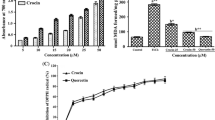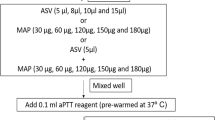Abstract
Viper envenomations are characterized by prominent local and systemic manifestations including hematological alterations. Snake venom metalloproteinases (SVMPs) and phospholipase A2 (PLA2) plays crucial role in the pathophysiology of hemorrhage by targeting/altering the platelets function which may result in thrombocytopenia. Platelets undergo the classic events of mitochondria-mediated apoptotic pathway due to augmented endogenous reactive oxygen species (ROS) levels. The observed anticoagulant effects during viper envenomations could be due to exacerbated platelet apoptosis and thrombocytopenia. Moreover, antivenin treatments are ineffective against the venom-induced oxidative stress; therefore, it necessitates an auxiliary therapy involving antioxidants which can effectively scavenge the endothelium-generated/endogenous ROS and protect the platelets. The present study explored the effects of viper venom on platelet apoptosis and its amelioration by a phytochemical crocin. The study evaluated the Vipera russelli venom-induced apoptotic events including endogenous ROS generation, intracellular Ca2+ mobilization, mitochondrial membrane depolarization, cyt-c translocation, caspase activation and phosphatidylserine externalization which were effectively mitigated when the venom was pre-treated with crocin. The study highlights one of the less studied features of venom-induced secondary complications i.e. platelet apoptosis and sheds light on the underlying basis for venom-induced thrombocytopenia, systemic hemorrhage and in vivo anticoagulant effect.






Similar content being viewed by others
References
Girish KS, Kemparaju K (2011) Overlooked issues of snakebite management: time for strategic approach. Curr Top Med Chem 11:2494–2508
Ushanandini S, Nagaraju S, Nayaka SC, Kumar KH, Kemparaju K, Girish KS (2009) The anti-ophidian properties of Anacardium occidentale bark extract. Immunopharmacol Immunotoxicol 31:607–615
Sunitha K, Hemshekhar M, Santhosh MS, Kumar MS, Kemparaju K, Girish KS (2011) Inhibition of hemorrhagic activity of viper venoms by N-acetyl cysteine: involvement of N-acetyl and thiol groups. Curr Top Med Chem 11:2589–2600
Sajevic T, Leonardi A, Krizaj I (2011) Haemostatically active proteins in snake venoms. Toxicon 57:627–645
Howes JM, Theakston RDG, Laing GD (2007) Neutralization of the haemorrhagic activities of viperine snake venoms and venom metalloproteinases using synthetic peptide inhibitors and chelators. Toxicon 49:734–739
Fox JW, Serrano SM (2008) Insights into and speculations about snake venom metalloproteinase (SVMP) synthesis, folding and disulfide bond formation and their contribution to venom complexity. FEBS J 275:3016–3030
Cortelazzo A, Guerranti R, Bini L, Hope-Onyekwere N, Muzzi C, Leoncini R, Pagani R (2010) Effects of snake venom proteases on human fibrinogen chains. Blood Transfus 3:s120–s125
Marinov I, Atanasov VN, Stankova E, Duhalov D, Petrova S, Hubenova A (2010) Severe coagulopathy after Vipera ammodytes ammodytes snakebite in Bulgaria: a case report. Toxicon 56:1059–1066
Kamiguti AS (2005) Platelets as targets of snake venom metalloproteinases. Toxicon 45:1041–1049
Wang WJ, Shih CH, Huang TF (2005) Primary structure and antiplatelet mechanism of a snake venom metalloproteinase, acurhagin, from Agkistrodon acutus venom. Biochimie 87:1065–1077
Cheng AC, Wu HL, Shi GY, Tsai IH (2012) A novel heparin-dependent inhibitor of activated protein C that potentiates consumptive coagulopathy in Russell’s viper envenomation. J Biol Chem 287:15739–15748
Rucavado A, Soto M, Escalante T, Lorı′a GD, Arni R, Gutierrez JM (2005) Thrombocytopenia and platelet hypoggregation induced by Bothrops asper snake venom: toxins involved and their contribution to metalloproteinase-induced pulmonary hemorrhage. Thromb Haemost 94:123–131
Leytin V (2012) Apoptosis in the anucleate platelet. Blood Rev 26:51–63
Jackson SP, Schoenwaelder SM (2010) Procoagulant platelets: are they necrotic? Blood 23:2011–2018
Kaplan ZS, Jackson SP (2011) The role of platelets in atherothrombosis. Hematol Am Soc Hematol Educ Program 2011:51–61
Yamashita KM, Nogueira TO, Senise LV, Cirill MC, Gonçalves LR, Sano- Martins IS, Giorgi R, Santoro ML (2011) Involvement of circulating platelets on the hyperalgesic response evoked by carrageenan and Bothrops jararaca snake venom. J Thromb Haemost 9:2057–2066
Samy RP, Pushparaj PN, Gopalakrishnakone P (2008) A compilation of bioactive compounds from Ayurveda. Bioinformation 3:100–110
Koehn FE, Carter GT (2005) The evolving role of natural products in drug discovery. Nat Rev Drug Discov 4(3):206–220
Santhosh SM, Hemshekhar M, Sunitha K, Thushara RM, Jnaneshwari S, Kemparaju K, Girish KS (2013) Snake venom induced local toxicities: plant secondary metabolites as an auxiliary therapy. Mini Rev Med Chem 13(1):106–123
Sebastin Santhosh M, Hemshekhar M, Thushara RM, Devaraja S, Kemparaju K, Girish KS (2013) Vipera russelli venom-induced oxidative stress and hematological alterations: Amelioration by crocin a dietary colorant. Cell Biochem Funct 31(1):41–50
Hemshekhar M, Sebastin Santhosh M, Sunitha K, Thushara RM, Kemparaju K, Rangappa KS, Girish KS (2012) A dietary colorant crocin mitigates arthritis and associated secondary complications by modulating cartilage deteriorating enzymes, inflammatory mediators and antioxidant status. Biochimie 94(12):2723–2733
Bakshi HA, Sam S, Feroz A, Ravesh Z, Shah GA, Sharma M (2009) Crocin from Kashmiri saffron (Crocus sativus) induces in vitro and in vivo xenograft growth inhibition of Dalton’s lymphoma (DLA) in mice. Asian Pac J Cancer Prev 10(5):887–890
Rosado JA, Graves D, Sage SO (2000) Tyrosine kinases activate store-mediated Ca2+ entry in human platelets through the reorganization of the actin cytoskeleton. Biochem J 351:429–437
Lopez JJ, Salido GM, Gómez-Arteta E, Rosado JA, Pariente JA (2007) Thrombin induces apoptotic events through the generation of reactive oxygen species in human platelets. J Thromb Haemost 5:1283–1291
Asai M, Takeuchi K, Uchida S, Urushida T, Katoh H, Satoh H, Yamada S, Hayashi H, Watanabe H (2008) Misinterpretation of the effect of amlodipine on cytosolic calcium concentration with fura-2 fluorospectrometry. Naunyn Schmiedebergs Arch Pharmacol 377:423–427
Salvioli S, Ardizzoni A, Franceschi C, Cossarizza A (1997) JC-1, but not DiOC6(3) or rhodamine 123, is a reliable fluorescent probe to assess delta psi changes in intact cells: implications for studies on mitochondrial functionality during apoptosis. FEBS Lett 411:77–82
Amor NB, Pariente JA, Salido GM, Rosado JA, Bartegi A (2006) Thrombin-induced caspases 3 and 9 translocation to the cytoskeleton is independent of changes in cytosolic calcium in human platelets. Blood Cells Mol Dis 36:392–401
Rosado JA, Lopez JJ, Gomez-Arteta E, Redondo PC, Salido GM, Pariente JA (2006) Early caspase-3 activation independent of apoptosis is required for cellular function. J Cell Physiol 209:142–152
Gutierrez JM, Escalante T, Rucavado A (2009) Experimental pathophysiology of systemic alterations induced by Bothrops asper snake venom. Toxicon 54:976–987
Luna KPO, da Silva MB, Pereira VRA (2011) Clinical and immunological aspects of envenomations by Bothrops snakes. J Venom Anim Toxins Trop Diseases 17:130–141
Hung DZ, Wu ML, Deng JF, Yang DY, Lin-Shiau SY (2002) Multiple thrombotic occlusions of vessels after Russell’s viper envenoming. Pharmacol Toxicol 91:106–110
Herath N, Wazil A, Kularatne S, Ratnatunga N, Weerakoon K, Badurdeen S, Rajakrishna P, Nanayakkara N, Dharmagunawardane D (2012) Thrombotic microangiopathy and acute kidney injury in hump-nosed viper (Hypnale species) envenoming: a descriptive study in Sri Lanka. Toxicon 60:61–65
Monteiro FN, Kanchan T, Bhagavath P, Kumar GP, Menezes RG, Yoganarasimha K (2012) Clinico-epidemiological features of viper bite envenomation: a study from Manipal, South India. Singap Med J 53:203–207
Park MH, Son DJ, Kwak DH, Song HS, Oh KW, Yoo HS, Lee YM, Song MJ, Hong JT (2009) Snake venom toxin inhibits cell growth through induction of apoptosis in neuroblastoma cells. Arch Pharm Res 32:1545–1554
Samel M, Trummal K, Siigur E, Siigur J (2012) Effect of HUVEC apoptosis inducing proteinase from Vipera lebetina venom (VLAIP) on viability of cancer cells and on platelet aggregation. Toxicon 60:648–655
Liu WH, Chang LS (2009) Reactive oxygen species and p38 mitogen-activated protein kinase induce apoptotic death of U937 cells in response to Naja nigricollis toxin-gamma. J Cell Mol Med 13:1695–1705
Park MH, Jo MR, Won D, Song HS, Han SB, Song MJ, Hong JT (2012) Snake venom toxin from Vipera lebetina turanica induces apoptosis in colon cancer cells via upregulation of ROS- and JNK-mediated death receptor expression. BMC Cancer 12:228
Leytin V, Allen DJ, Mutlu A, Gyulkhandanyan AV, Mykhaylov S, Freedman J (2009) Mitochondrial control of platelet apoptosis: effect of cyclosporin A, an inhibitor of the mitochondrial permeability transition pore. Lab Invest 89:374–384
Danial NN, Korsmeyer SJ (2004) Cell death: critical control points. Cell 116:205–219
Acknowledgments
Sebastin Santhosh. M thank the Council of Scientific and Industrial Research (CSIR), Government of India, New Delhi, India, for financial assistance (SRF- Ref: 9/119(0191)2K12EMR-I dated 28-02-2012. Authors thank central instrumentation facility, University of Mysore, Institute of Excellence Project, MHRD (Government of India).
Conflict of interest
The authors declare that there are no conflicts of interest.
Author information
Authors and Affiliations
Corresponding author
Rights and permissions
About this article
Cite this article
Santhosh, M.S., Thushara, R.M., Hemshekhar, M. et al. Alleviation of viper venom induced platelet apoptosis by crocin (Crocus sativus): implications for thrombocytopenia in viper bites. J Thromb Thrombolysis 36, 424–432 (2013). https://doi.org/10.1007/s11239-013-0888-x
Published:
Issue Date:
DOI: https://doi.org/10.1007/s11239-013-0888-x




